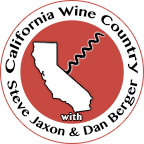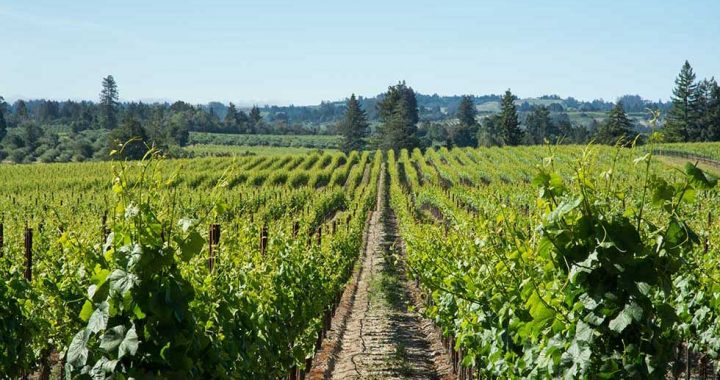Podcast: Play in new window | Download (Duration: 38:18 — 17.7MB) | Embed
Subscribe: Apple Podcasts | RSS | More
Barbara Lindblom visits with Steve Jaxon and Dan Berger today, to remember Mary Ann Graf, a pioneering, iconic local winemaker who passed away recently. Barbara Lindblom also worked at Simi Winery (as laboratory director) then as a winemaker in some other places. She is now retired.
Mary Ann Graf studied at UC Davis and was the first woman in the US to graduate with a degree in Oenology. She was the winemaker at Simi Winery, the first in a series of notable women winemakers there. Then, she ran a successful laboratory testing company called Vinquiry, which performed testing services for wineries. She was the first woman on the board of directors of the American Society for Enology and Viticulture
Mary Ann Graf worked with André Tchelistcheff. They will taste a non-vintage Simi North Coast Burgundy, which Dan can see is from 1973, from the code printed at the bottom of the bottle. This was Mary Ann’s first year at Simi. Dan bought these wines at Trader Joe’s for $1.99 per bottleMost of the major wineries in those days made a generic so-called Burgundy and most of them were blends.
Mary Ann Graf started Vinquiry at about that time. Dan knows it as one of the most professional wine analysis laboratories at the time. She had a lot of clients in Alexander Valley.
Barbara Lindblom started working at a harvest at Mondavi with Zelma Long. When Zelma got the job as Simi, she asked Barbara to join her, and she worked there for 10 years. Dan Berger says that Zelma Long and André Tchelistcheff were a strong team, since André was more inclinded to understanding wine from its sensory perception and Zelma understood it more from the technical standpoint.
Barbara remembers Mary Ann was so generous with her time and her thoughts, and a steadfast friend. Her consulting business grew and grew because she and her partner were so smart and patient with their clients.
Dan remembers when he and Mary Ann were judges in a competition in the midwest where the wine was really bad. Dan remembers she was so kind and quiet. A winemaker from Illinois asked her, “Did you like my wine?” She replied kindly, “We can talk about this, you’ve got potential.” She could not say anything negative about it. As a consultant, she would tell her clients what’s there and what can make it better. She was always looking out for the best long-term solution, not a quick fix.
They taste a 2000 Old Vine Zinfandel from Fanucci vineyards and a 2016 Stonestreet Estate Chardonnay that is a good example of Alexander Valley fruit having enough acidity to age well.
Barbara Lindblom spent some time in France and Spain as well as working as a winemaker in California.
Dan brought in a Simi North Coast Burgundy from 1973. This was Mary Ann Graf’s first year at Simi. It is only 12% alcohol, mostly Carignane and a bit of Zinfandel. Dan says that wineries had their blends with all kinds of different varietals that they all called Burgundy. They were the varietals that were in their high end portfolios, but the leftover wines were also good.
Dan Berger tasted wine with Joe Coulombe at Trader Joes in the 1970s and remembers tasting these wines.
Giuseppe and Pietro Simi selected their location, five years before Italian Swiss Colony was founded.
They used to call a generic red wine “Mountain Burgundy” often based on Carignane which was a workhorse variety that was never intended to be aged. Dan discovered some old bottles of it in the back of his cellar and they were fine. There was a little oxidation. There was some fruit flavor, but dried fruit, being 40 years old. Zinfandel doesn’t age as well as Carignane, but it does live long. Dan says the smell this 1973 wine has is a precursor of oxidation.
Dan and his wife were in Madrid at the Sporting restaurant in Madrid. They said they had a 1971 Baron Delay Rioja, which cost him $11 US. The waiter said the Spanish don’t like aged wine, since they age the wine in the barrels. Dan says that wine was glorious for 20 minutes, but they watched it turn and five minutes later it was dead.
Dan says that this 1973 will turn from red to brown in an hour, so drink it fast! Steve asks why that happens and Barbara explains it. In any case, it tastes wonderful. The year before, which was made by someone else, is no good anymore.
Dan’s cellar is underground and has a constant temperature of 55-60 degrees year-round.
Finally, as they toast to Mary Ann with her wine, Dan remembers that Mary Ann Graf never sought publicity and was always striving to improve. Her name only shows up in his columns 5 or 6 times over the decades because she never wanted publicity.

